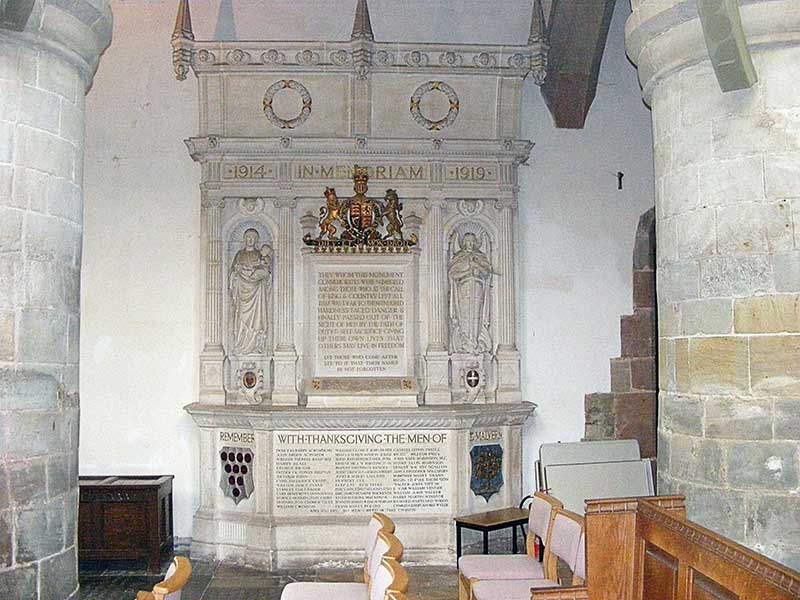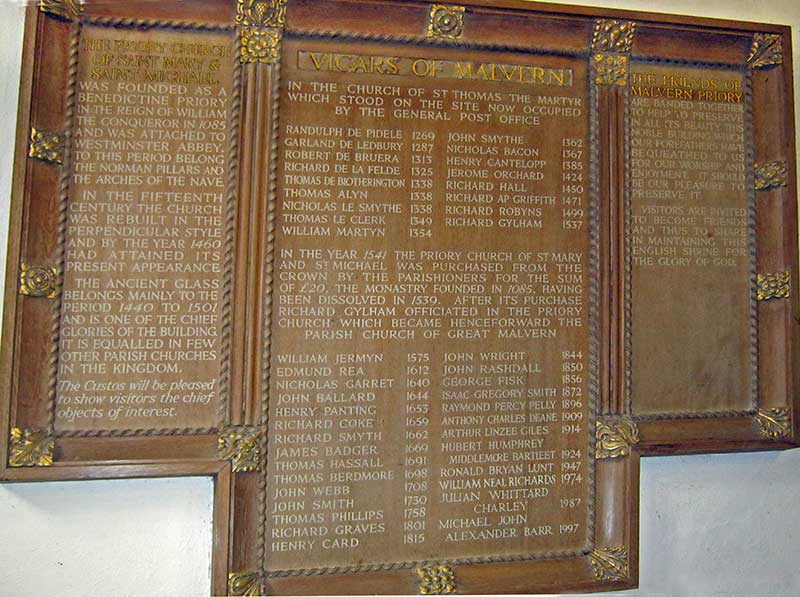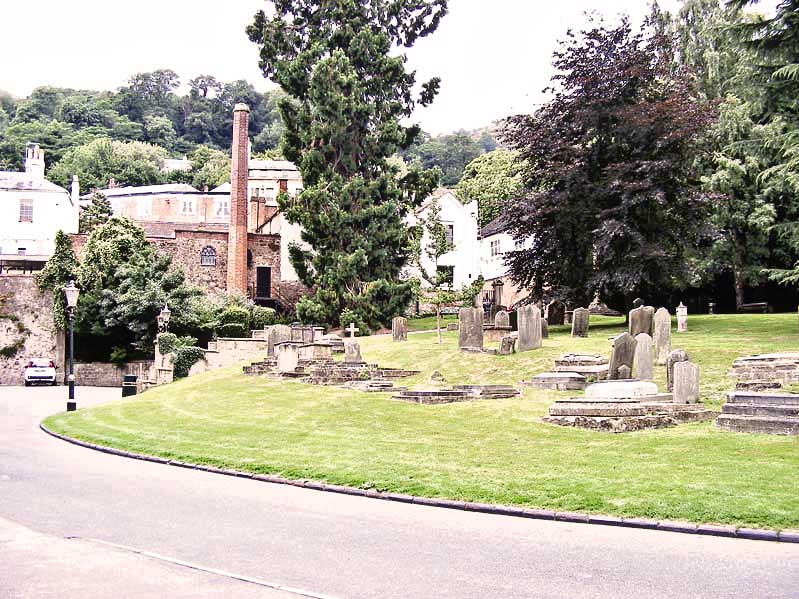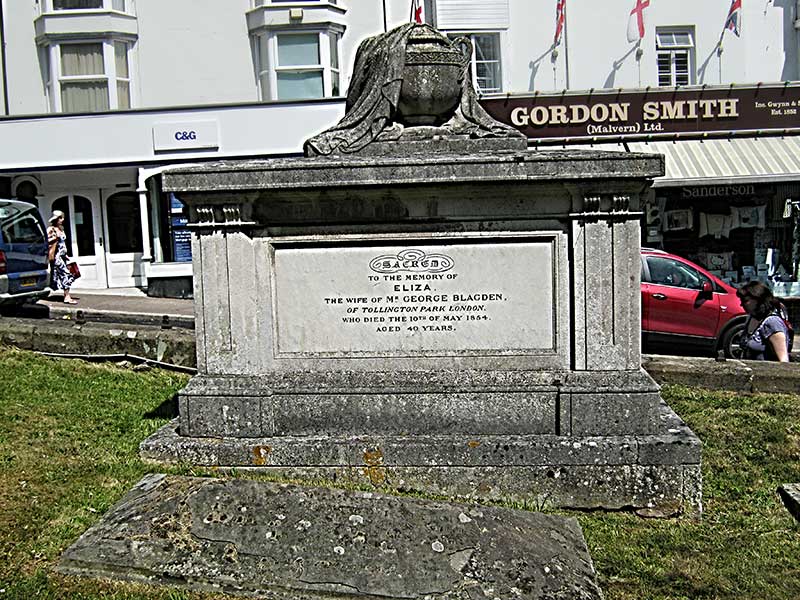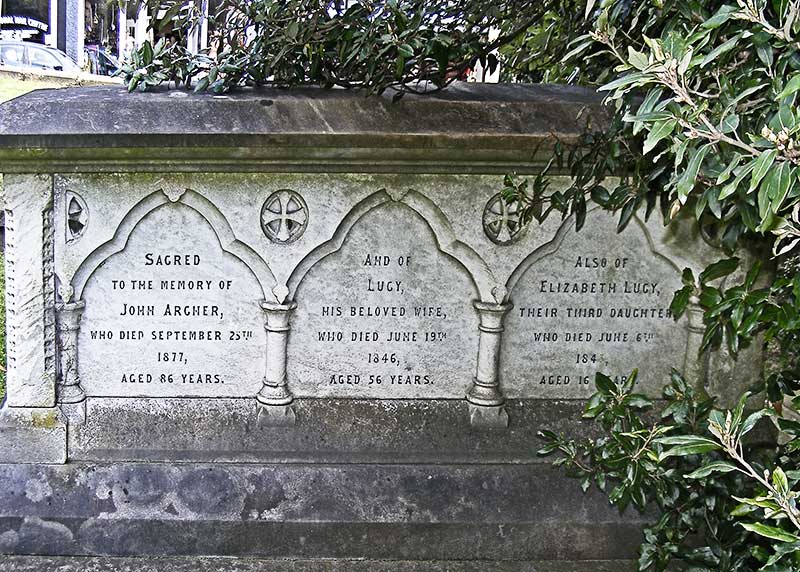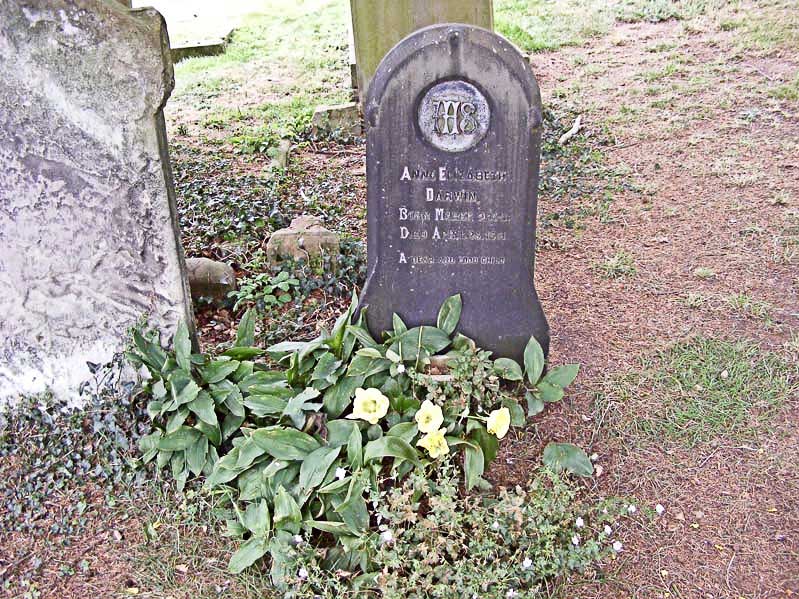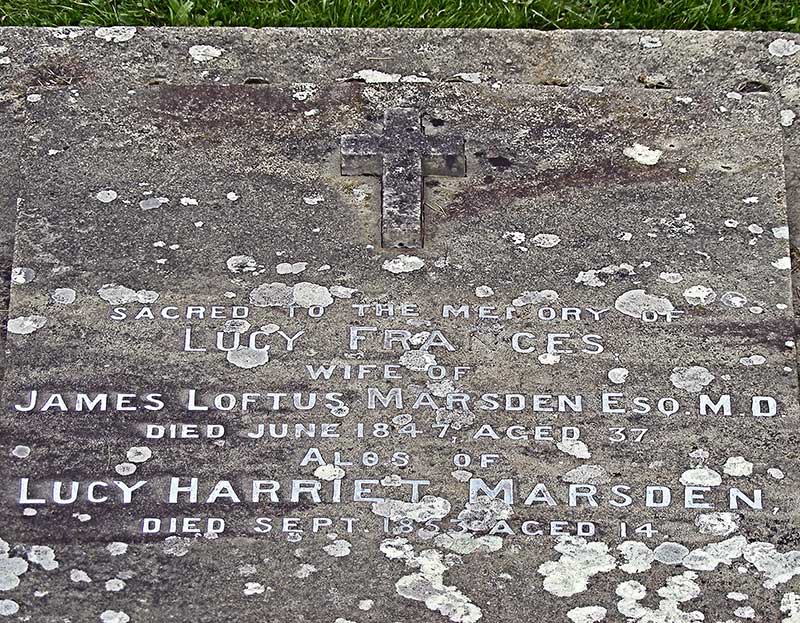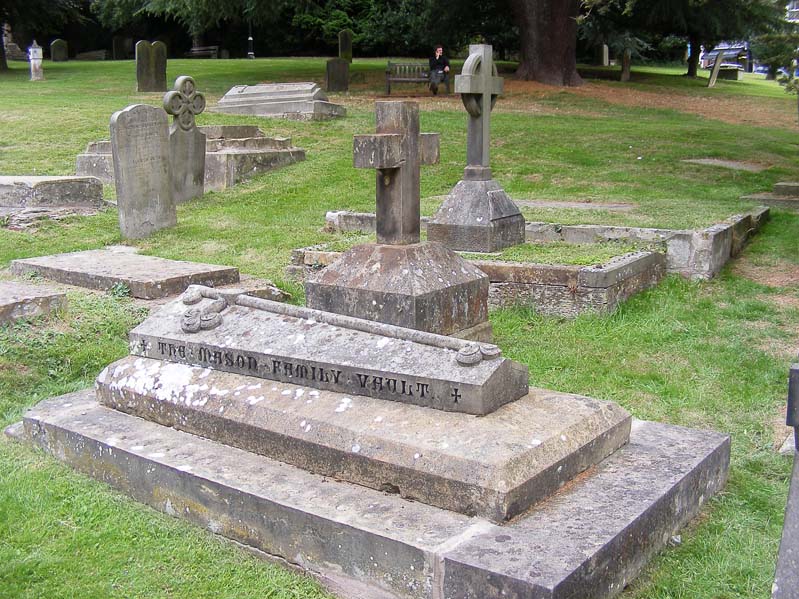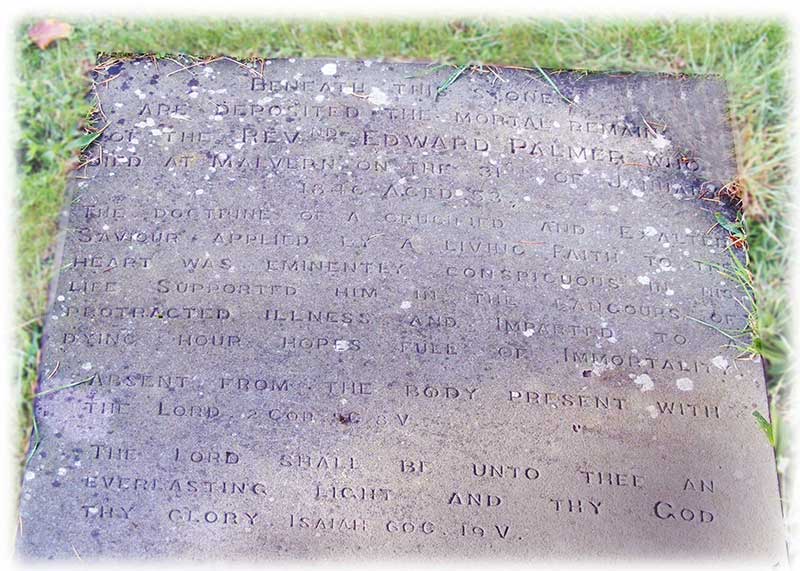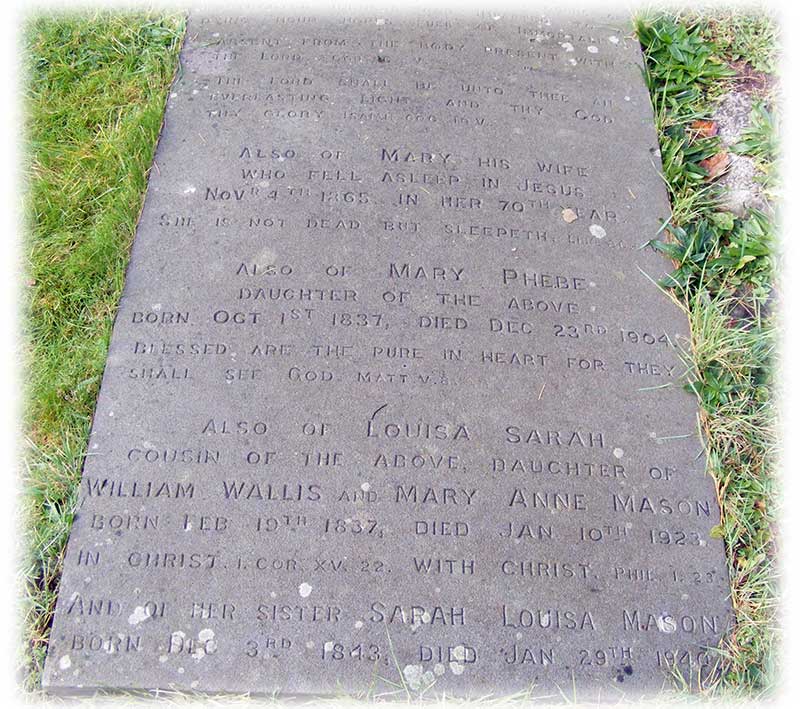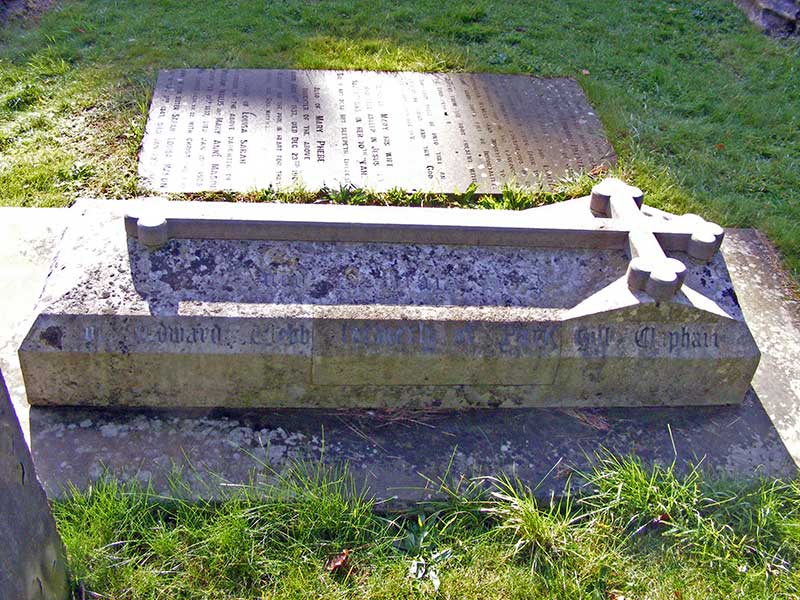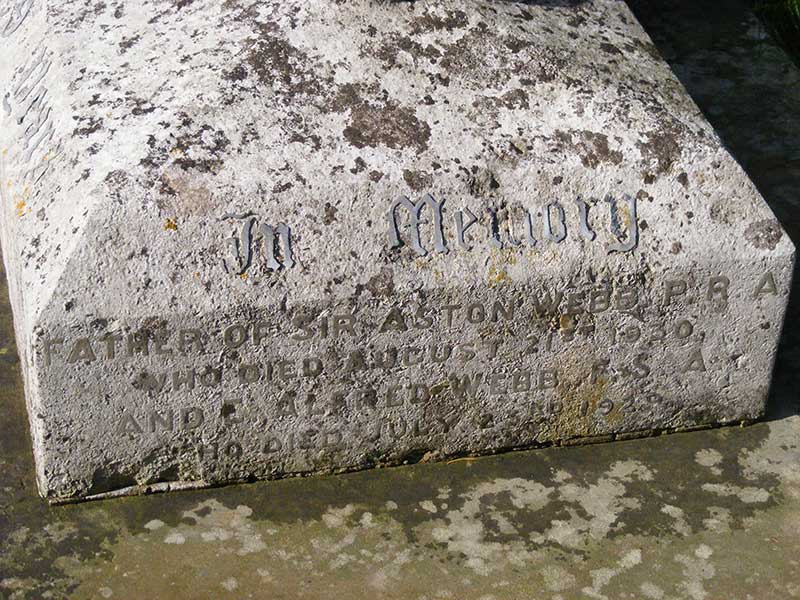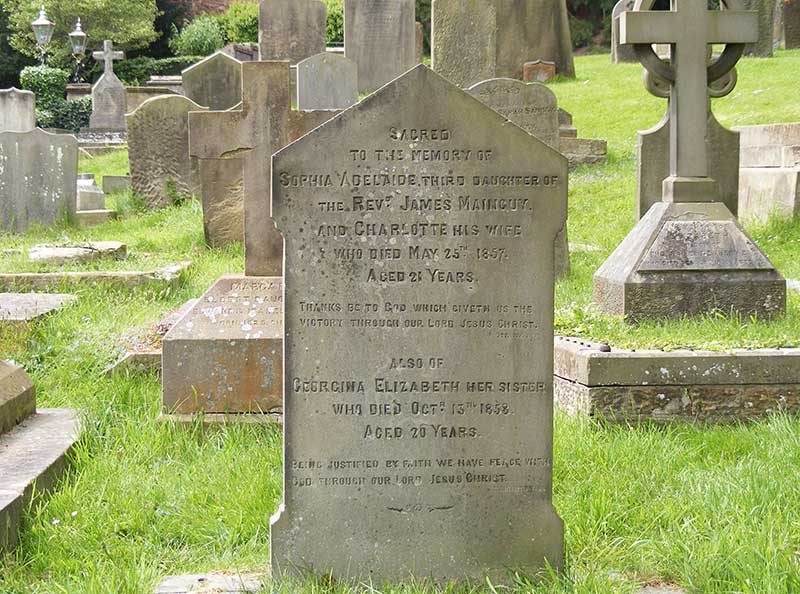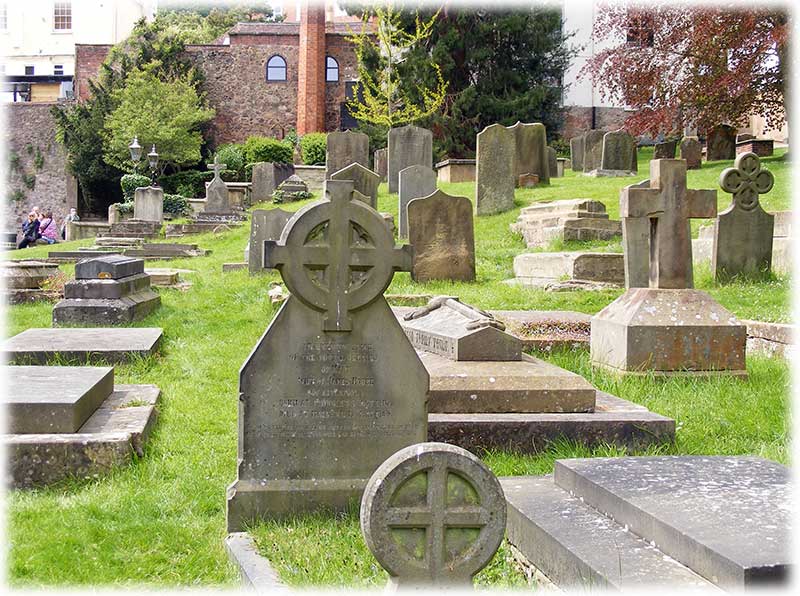
Angus and Rosemary's Miscellany
of Malvern - Local History
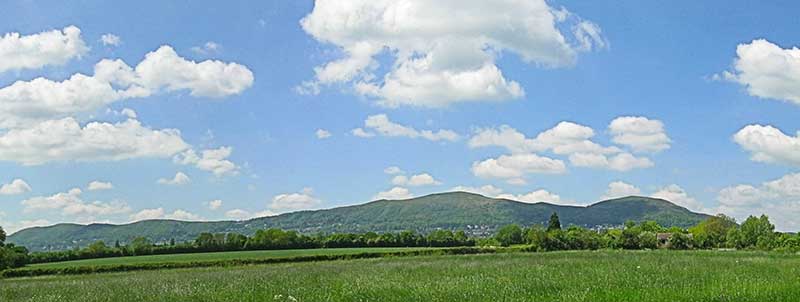
History menu > Great Malvern Priory and its churchyardThe Priory lies on the south side of Church Street in the cente of Great Malvern. It is a well supported ancient Church with a thriving congregation of both young and old. We recommend you drop in if you are visiting the town to sit quietly and soak up the peaceful atmosphere.
Great Malvern Priory and Abbey Hotel viewed from Foley Terrace This page is mainly a repository for miscellaneous historical information we have collected about people with links to The Priory Church of St Mary and St Michael - the parish church of the town of Great Malvern. It is not intended as a detailed history of the Priory as you will find that elsewhere (for example see ref 13 which tells the story of the Priory from its foundation to the dissolution of the monastries); nor is it a place to learn more about the ministry of the parish of Great Malvern today - you can learn about that either by visiting the church in person or looking at the Great Malvern Priory website. We have added to the original article a description of the War Memorial inside the church, plus photos of just a few of the monuments in the churchyard, and some stories about people who are buried there - but there are many more for local historians to explore. ContentsAbout Great Malvern PrioryGreat Malvern Priory was built as a monastery circa 1100 AD. Following the dissolution of the monasteries by Henry VIII the building was acquired by the townspeople about 1540 and became the parish church of Great Malvern replacing the old church of St Thomas which stood on the site of the present Post Office. Great Malvern Priory (see photo below) is a popular attraction for visitors. Services, musical and other events are well attended.
The north side of Great Malvern Priory We visited on Saturday 13th July 2013 on the occasion of a Flower Festival, celebrating the 50th anniversary of the Malvern Floral Art Club, the money raised to be divided between Great Malvern Priory and the Friends of Malvern Community Hospital. The Festival was called 'Golden Fanfare'. The photo below was taken from the back of the nave looking towards the altar. 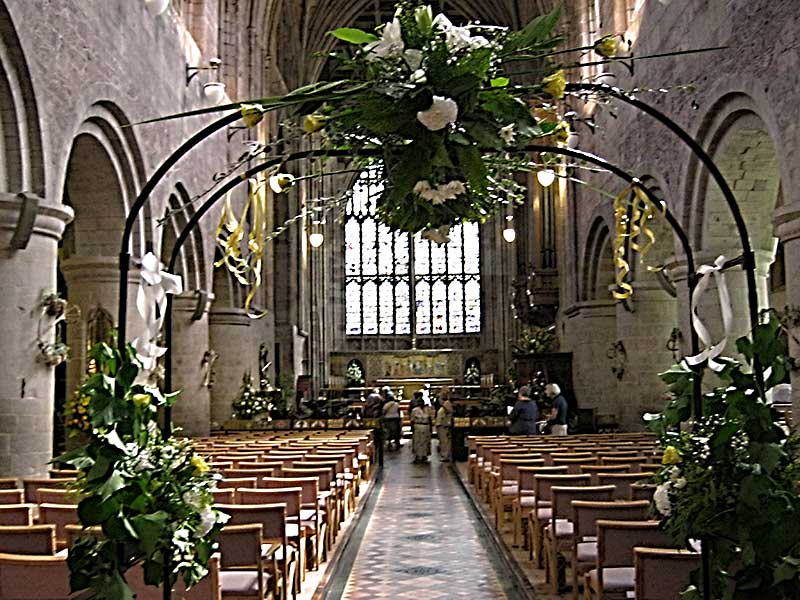
Rev John Rashdall
Peter, then the Custos, was able to direct us to the brass plaque high up on the rear wall of the Apse behind the altar (see photo opposite). The inscription on the plaque reads, In memory of Revd John Rashdall MA vicar of this church from 1851 to 1856, during which time the tower was restored and the district church of Holy Trinity Great Malvern was built. He died at Dawlish February 5th 1869 in the 60th year of his age. John Rashdall was the father of Oxford theologian Hastings Rashdall. The building of Holy Trinity in North Malvern was expedited by a large donation from local benefactor Charles Morris and his sister Jane, who lived on the Worcester Road. Rev George FiskAnother plaque inset into one of the large columns of the north aisle remembers Rev George Fisk who was the next Vicar of Great Malvern and had led the burial service of the water cure Doctor James Wilson MD in 1867.
To the glory of God and in loving remembrance of the Rev George Fisk LLB, prebendary of Lichfield and Vicar of Malvern from 1856 to 1872. Mainly by whose exertions this church was completely restored. In commemoration of his zealous labour for the spiritual welfare of this parish, his parishioners and friends have united to build a memorial church, for the new parish of Christchurch, and place this tablet to record the fact of its erection AD1876. The foundation stone of Christchurch was laid by Lady Emily Foley on 17th September 1874, and the church dedicated by the Bishop of Worcester on 28th December 1875. George Fisk died on August 31st 1871 and is buried in Great Malvern Cemetery on the south side of the chapel. Edward ChanceA few yards away if you look up you will see a tarnished memorial which is not well lit. It is a memorial to Edward Chance who once lived at Lawnside in Albert Park Road and is mentioned in our story about past schools, and whose burial is recorded on our page about Great Malvern Cemetery. The photo below shows just the inscription which is surrounded by elaborate scroll work. 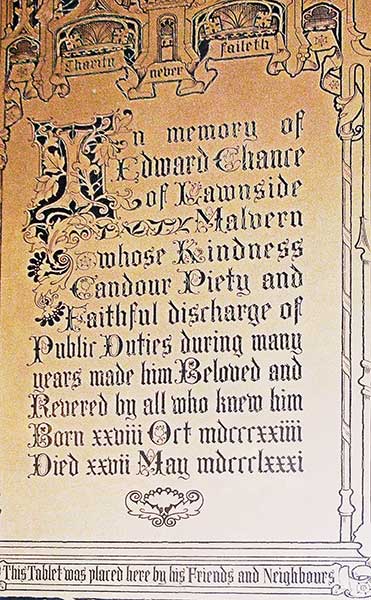
The touching inscription begins, 'Charity Never Faileth' and then continues, In memory of Edward Chance of Lawnside, Malvern whose kindness, candour, piety, and faithful discharge of public duties during many years made him beloved and revered by all who knew him. Born 25th October 1821 Died 27th May 1881 This tablet was placed here by his friends and neighbours.
William Bennett Garlike MD
His only daughter Mary Garlike is buried in the churchyard of St Mary Guarlford where the monumental inscription mentions that her parents were buried in a vault at Great Malvern Priory. The Custos was also able to direct us to a tablet on the north wall of the Priory (see opposite). The tablet is difficult to read now, as the lettering is fading in parts, but here is what the inscription says:
Note: Lydia Garlike died 25 January 1835 aged 77 and in our Bible the quotation from Psalms is verse 13. Her husband William Bennet Garlike, Physician, was listed in in Pigot's Directory of 1828.
Dr Garlike's vault 1835 The ledgerstone would originally have marked the position of the vault, near the tablet, but many were moved in Victorian times. We were told by the Custos that burials within the Priory were discontinued about 1851. Francis Moreton
Francis Moreton of the Pale, in the Parish of Leigh, Gent. Died 28th and was buried here 31st day of July Anno Domini 1714 aged 79 years and 6 months. Also Lisset his wife, daughter of Henry Doverdale of Crowl, Gent, who died 31st of March, was buried here the 2nd of April AD 1717 aged 72. Also in memory of Joseph, son of Joseph and Hannah Stokes who died the 21st May Anno Dni 1721 aged 9 months. Short was my time, the longer is my rest. Hoping in Christ to live amongst the Blest. Francis Moreton, who would have been aged 17 years at the time of the Battle of Worcester, probably owned land at or near the site of Pale Manor Farm where ADRDE was located during WWII (ref 12). Please do let us know if you can tell us anything about this family's place in history. Thomas WoodyattInside the Priory, at the rear of St Ann's chapel, in the south-east corner of the church, is a memorial to Thomas Woodyatt, a naval officer who died in 1841, and his wife Harriet. The inscription reads,
His widow died on the 31st January 1863 in her 88th year and was buried in the same vault. Dyson PerrinsOn a pillar of the north aisle is a tablet in memory of James Dyson Perrins of the Worcestershire Sauce family, and others.
The tablet reads: TO THE GLORY OF GOD This tablet commemorates the thanksgivings of the inhabitants and others in the Jubilee year of Queen Victoria. The bells, the belfry, the clock and quarter chimes were restored by their thankofferings. The new tenor and fourth bells were given by Ellen Mary Dixey in memory of her father James Dyson Perrins, Davenham Bank, Malvern. The new treble bell was the gift of Edward Archer, Littleford Lodge, Malvern, and this tablet was the given by William Hayes, Newtown House, Malvern, 1887. In more recent times, Ellen Mary Dixey's grandaughter, Mary Dixey, was another supporter of the Priory, and started the bookshop.
The inscription reads: The clappers of the old ring.... Our duty done in belfry high, now voiceless tongues at rest we lie. Preserved by Edward Archer 1887. Above the clappers are the words, Belfry, Oak, 1611. Wine merchant Edward Archer lived in Graham Road at Littleford Lodge, which is now the Cotford Hotel. His father hotel keeper John Archer once owned the Foley and Abbey hotels. The War MemorialThe War Memorial is located inconspicuously in the northwest corner of the church opposite the main door.
The inscription in the centre reads:
The fallen of WWIAt the base is an inscription, and below are listed the names of the fallen of the Great War, 1914 - 1919 Remember with thanksgiving the men of Gt Malvern Donald Harry Acworth MC John Arden Acworth William Thomas Banford Harry Beale George Brodie Frederick Edward Bruton Arthur Bunn Cyril Frederick Crapp William Jabez Evans Stanley Colt Faber Cyril Henry Rowland Foxwell Horace Boddington Gibbs Mornington George Giles William Grendon William George John Heath Malcolm Hutchinson House Alban John Benedict Hudson MC Ernest Henry Huntingdon Robert Hastings Kendle Albert Francis Gerald Lambert Joseph Albert Layland Herbert Lee Douglas Cecil Leek Percy Arnold Lloyd-Jones DSO Eric James Bethune MacKenzie Keith Bethune MacKenzie Ronald Charles Wybrow Morgan Frank Bailey Perkins Charles Edwin Preece Victor William Price John Yate Robinson MC Henry Ellis Robinson Ernest Wilmot Scalion James Frederick Spillsbury Humphrey Nisbet Swan Reginald Paul Thompson Walter John Tipton Edgar William Venner William John Walker Harry Martin Windsor Richard Hartland Woods Charles Gilbert Andree Wylde And others who worshipped in this church You can find stories about many of the men above on the Malvern Remembers website. The fallen of WWIIAbove is a small tablet recording the fallen of the 1939 - 1945 war. Henry Brooks Brown Stanley Hudson Burley Philip John Lancaster Crook Paul Nelson Dobie Vernon Richard Mason David Henry Milward Anthony Irving Phelps Charles Jack Pitchford James John Taaffe John Cedric Rowland Type Guy Taylor Philip Mascie Domville Wynter Peter Norman Walker Peter Harold Wheelock PlaqueOn the external east wall of the Priory is a terracotta plaque listing men of the Great War. The inscription reads: Temporary wooden crosses from the First World War graves of these soldiers stood here for many years from 1922 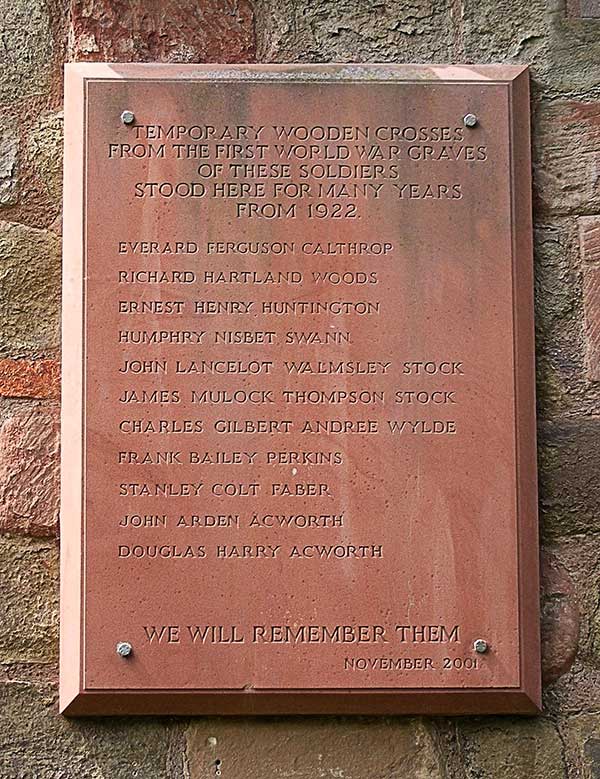
Everard Ferguson Calthrop Richard Hartland Woods Ernest Henry Huntington Humphry Nisbet Swann John Lancelot Walmsley Stock James Mulock Thompson Stock Charles Gilbert Andree Wylde Frank Bailey Perkins Stanley Colt Faber John Arden Acworth Douglas Harry Acworth We will remember them November 2001 Many of these men are also recorded on the Roll of the Fallen at the library. Vicars of MalvernAs you enter the church, on the west wall, to your right, can be seen a board listing past Vicars of Malvern - see photo below.
The ChurchyardWe occasionally walk through the churchyard (see photo below), up to Belle Vue Terrace, while out shopping in Great Malvern, but until recently have given little thought to the monuments and inscriptions. It looks as though most burials ceased many years ago, though there are a few as late as 1920. Many of the inscriptions have weathered and are now barely legible.
We had not discovered any on-line records of burials in the Priory churchyard until August 2013 when we came across the gravestonephotos.com website which at that time recorded 100 memorials. Some memorials can also be found listed on the www.findagrave.com website to which it is recommended you add your own photos and research. The Find a Grave website currently lists 49 memorials in Great Malvern Priory churchyard. Below is a record of the memorials we have researched, some of which were on behalf of the Guarlford History Group. Click to view list of Guarlford History Group stories. Eliza BlagdenAs you walk up Church Street you will see a large box tomb on the NW corner of the churchyard, and we wondered if it was the burial place of a famous or prominent Malvern citizen.
The inscription on the monument reads:
According to the census Eliza was born Portsmouth about 1814 and her husband was born Tinsley, Yorkshire, about 1814. There is no evidence of the family living in Malvern, so we wonder if she had been ill and came to Malvern for the 'water cure'. The 1851 census records the family at Warnsworth in Yorkshire and George's occupation as - occupier of limestone quarries, lime burner, and farmer of 50 acres employing 3 labourers. Later he is recorded living in the district of Tollington Park in London and giving his occupation as, Railway shares, houses and land. Eliza and George had five children, William George Blagden, Thomas Blagden, Eliza Blagden, Joseph Blagden, and Charles Washington Blagden, at least one of whom was a limestone merchant. The Archer familyA little lower down the slope is the box tomb of John Archer who was a well-known Victorian hotel keeper - he once owned both the Foley and Abbey hotels and his youngest son Edward later owned a Wine Merchant business between the Foley Arms and the present Barclays bank. Panels on the monument record the deaths of John's wife Lucy and six of their seven children.
The inscriptions on the monument read:
John and Lucy's eldest daughter Emma married hotel-keeper Frederick St George. Emma's name cannot be seen on the monument, but the death of her eldest daughter Alice is recorded on the east face, which was overgrown by foliage, when the photo above was taken. Alice Lucy Blanche St George, grand daughter of John Archer, died 11th January 1864 aged 19 years and was buried in the churchyard of Great Malvern Priory on the 15th. Click here to read more about John Archer and his family. Anne Elizabeth DarwinLower down the slope, beneath trees, towards the tarmac footpath is a small headstone (see photo below taken in August 2013).
The inscription reads: Anne Elizabeth Darwin Born March 2 1841 Died April 23 1851 A dear and good child Anne was the daughter of Charles Darwin author of Origin of the Species. He had brought her to Malvern to see if her failing health could be improved by the water cure (ref 3 and 4) but it was not to be. Since the photo above was taken the overhanging trees have been cut down and the monument restored. Lucy Frances MarsdenLucy Frances Marsden died in childbirth at Malvern in 1847 and is buried in the churchyard of Great Malvern Priory (see photo of the inscription on the gravestone below).
She was the wife of water cure doctor James Loftus Marsden MD who had built Hardwicke House and Elmsdale in Abbey Road. Lucy's maiden name was Rashdall (click to read about her brother John Rashdall above). Her eldest daughter Lucy Harriett Marsden who died in 1853 is buried with her. The inscription, which has lately been highlighted in silver/grey paint, reads:
Holes in the surrounding slab suggest the grave may once have been protected by iron railings. Lucy's husband Doctor James Loftus Marsden, who was an exponent and practicioner of Homeopathy and the Water Cure, married twice more and died at Elmswood, Ashburnham Road, Hastings on 6th February 1891. He was buried in Hastings Cemetery on 12th February next to his daughter Rosa Sydney Marsden who had died at St Leonards in 1877 aged only 34 years from an overdose of medicine. Sadly, James Loftus Marsden's memorial has no inscription, other than the initials JLM and the words 'Jesus only' added to his daughter Rosa's headstone. The Mason familyNearby, about 10 yards to the east, is a monument bearing the words 'The Mason Family Vault' (see photo below). There are no names on the monument, but no doubt these will be contained in the Priory records.
Circa 1782 the Mason family inherited a large parcel of land known as the Nether Grange Estate surrounding Great Malvern Priory. This passed to an Oliver Mason (1787 - 1871) who in the 1840s sold plots of land for housing and Dr James Wilson's hydropathic establishment, now known as Park View. Possibly this is the resting place of Oliver Mason. Rev Edward PalmerOliver Mason's sister Mary married the Reverend Edward Palmer vicar of St John the Baptist, Deritend in Birmingham. They are buried ten yards further on towards the church porch with other members of the extended Mason family. The photograph below highlights the inscription at the top which, though weathered, is still legible.
The memorial reads:
The photograph below shows the lower portion of Edward Palmer's memorial containing the names of the Mason family.
Edward WebbImmediately to the north of Edward Palmer's grave is the resting place of Edward Webb (1805-1854), a landscape watercolour painter and steel engraver, who died at Malvern. He studied under the engraver John Pye and later with Copley Fielding and David Cox RWS, the elder, (1783-1859) a famous member of the Birmingham School of Landscape Painters. Edward made many English and French tours, and visited Scotland in 1834 and Wales in 1837 and 1840 with David Cox's son who was also a painter. The son also named David Cox AWRS (1809 - 1885) studied under his father and often imitated his style. The photograph below shows Edward Webb's memorial topped by a cross; also in the picture is the grave of Rev Edward Palmer mentioned above.
The inscription on the top of the tomb is very worn now, but reads on one side: Edward Webb who died 9th October 1854 aged 49 years The other side reads: Edward Webb of Park Hill House, Clapham, Surrey At the foot of the tomb has been added: In memory Father of Sir Aston Webb PRA who died August 21st 1930 and E Alfred Webb FSA who died July 23rd 1939 See photo below.
Edward was the son of Charles Tarr Webb (1774-1849) and Ann Aston. His father Charles is recorded as a Gold Lace maker of 48 Picadilly in the parish of St James, Westminster. It seems likely his business was concerned with embellishing military uniforms. Charles will indicates he owned several properties and his children included Charles Tarr 'junior', John, Edward (buried at Great Malvern), William, and Richard who died before his father leaving a widow. An executor was George Webb Sandford (1813-1892) of 47 Picadilly, who became President of the Pharmaceutical Society 1863-1868. Charles Tarr (junior 1797-1862) carried on the family business of his father. At the time of his death he is recorded as a Gold Lace Manufacturer of 23 Bond Street, with a house at Hoddesdon in Hertfordshire. He is said to have become very wealthy through supplying the military during the Crimean War. A pattern book indicates his business:
Edward's brother John was a collector of fine art and an adviser to the Victoria and Albert museum. His obituary was published in the London Times on 21st June 1880. Perhaps it is not surprising, given this background, that Edward became a landscape painter. In 1844 Edward married Anna Evans, daughter of drug merchant John Evans at St Bartholomews in London. Sadly not long after Anna died at Versailles in France on 17th October 1850. Edward and Anna's two surviving sons were Aston Webb who become a famous architect and his brother Edward Alfred Webb who wrote a history of St Bartholomews and is listed in the census as a wholesale druggist. Nowaydays he would be described as a 'pharmaceutical supplier'. Aston Webb was elected President of the Royal Academy 1919-1924. His many designs included Admiralty Arch and the Victoria Law Courts in Birmingham. The initials after the name of his brother Edward Alfred Webb suggest he was a Fellow of the Society of Apothecaries. The Mainguy daughtersIn Great Malvern churchyard are buried two sisters, the daughters of Charlotte and Revd James Mainguy.
The inscription on the headstone reads, Sacred to the memory of Sophia Adelaide third daughter of the Revd James Mainguy and Charlotte his wife who died May 25th 1857, aged 21 years Thanks be to God, which giveth us the victory, through our Lord Jesus Christ I Cor XV 17 Also of, Georgina Elizabeth her sister who died Oct 13th 1858, aged 20 years Being justified by faith we have peace with God through our Lord Jesus Christ Romans V 15 Not many people know that Charlotte's three younger sisters are buried not far away in the churchyard of St Mary Guarlford, which was once a chapel of ease under the jurisdiction of Great Malvern Priory. Charlotte and her sisters were the daughters of Major General William Henry Beckwith. William's father and brothers had distinguished military careers and two are listed in the Oxford Dictionary of National Biography. You can read more about the Beckwith family by clicking this link Charlotte's son Daniel Wishart Mainguy emigrated to Canada and became a farmer. In 1884 he married Mary Elizabeth Fry. He died 1906, Vancouver Island, British Columbia (ref 8). One source suggests that Daniel and Mary were the parents of Edmund Rollo Mainguy OBE (1901-1979). Rollo joined the Royal Canadian Navy and became a Vice Admiral. He graduated from the Naval College of Canada in 1918. During WWII he served in Destroyers. In 1946, he was Flag Officer Pacific Coast. He was appointed Chief of Naval Staff in 1951 and retired in 1956. As far as we know the Beckwith and Mainguy families had no connection with Malvern, so perhaps they first visited Malvern for health reasons and the water cure, later some retiring to Malvern in old age. Mary MooreJust south of the memorial to the Fancourt sisters is the headstone of Mary Moore.
The inscription on the headstone reads, The resting place of the mortal remains of Mary, wife of James Moore (of Liverpool) Born at Knowsley 8th Oct 1819 Died at Malvern 19th May 1859 For if we believe that Jesus died and rose again, even so them also which sleep in Jesus will God bring with him. I Thess 4.14 Mary Moore, maiden name Statter, had married, 14th May 1840 at Huyton Church, James Moore. James Moore, a merchant in Liverpool, was born 1804 in the Isle of Man and died 1886 at Cheltenham. His brother Joseph Christian Moore, died 1886, became Rector of Andreas in 1844 and later Archdeacon of the Isle of Man. Family of Mary MooreMary's sister Margaret married, 1845 at Huyton, Revd John Jackson MA (1817 - 1891), educated St John's College Cambridge, who in 1851 was vicar of Dodderhill, Droitwich. Soon after he seems to have become Rector of Fulletby in Lincolnshire, before becoming Rector of Ledbury circa 1861 until his death in 1891. John and Margaret had only one son John Alcomb Jackson, a trainee solicitor, who sadly died at Ledbury in 1873 aged only 19 years; he is buried in Malvern Cemetery. Mary's sister Elizabeth married a Cotton Broker, James William Thompson, who died at Seafield House, Chester in 1885. They had one daughter Mary Emily Thompson (1862 - 1931). Mary and James Moore were reported as having seven children, in a history of Manx families, but we have found evidence of only four in the census:- Elizabeth Moore born 1841 at Huyton, married 1862, Henry Stockley, an insurance adjustor who died in 1873, by whom she had three children. Robert Statter Moore (1843 - 1889) married 1881, Mary Rachel Reid; they had no issue. Emily Margaret Moore (1845 - 1921) married 1865, Henry Christian, the son of a banker, born Valetta, Malta, who was a naval officer and a Member of the Victorian Order (MVO). He died at Heighthorne, The Park, Cheltenham in 1916, a retired rear-admiral in the Royal Navy, who was Chief Constable for Gloucestershire from 1865 to 1910. There is a memorial to Henry in Gloucester Cathedral. Click here for a photo. Emily died at Witcombe Park in Gloucestershire in 1921. Henry Edvardus (or Edward) Moore born about 1850 at Huyton married 1877, Harriet Smith. They spent some time in New York, where their daughter Mary Gertrude Moore was born in 1879, before returning to England. In the 1911 census he is recorded as a farm manager at Little Compton, Pershore. Click to continue to next page References
If you are able to correct or add to this page please get in touch by contacting the webmaster |
|
Last updated 21st April 2019 |
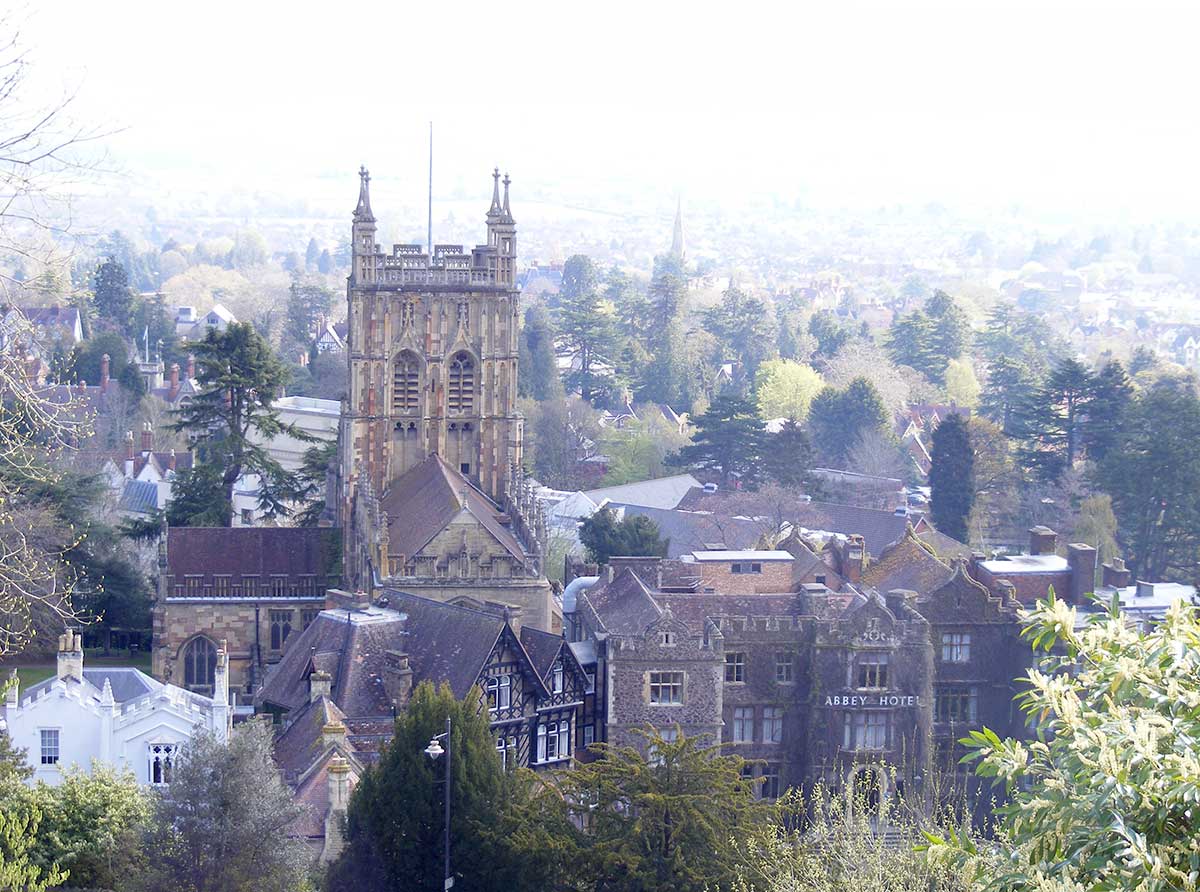
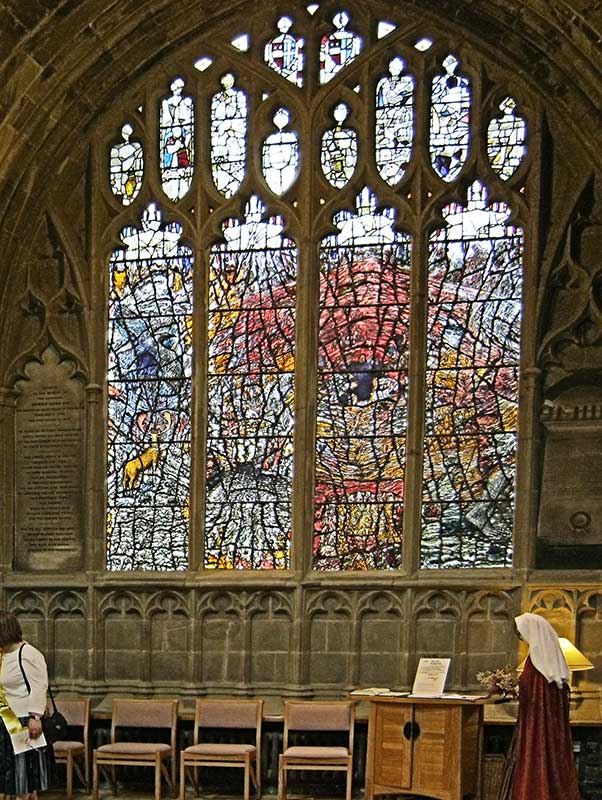
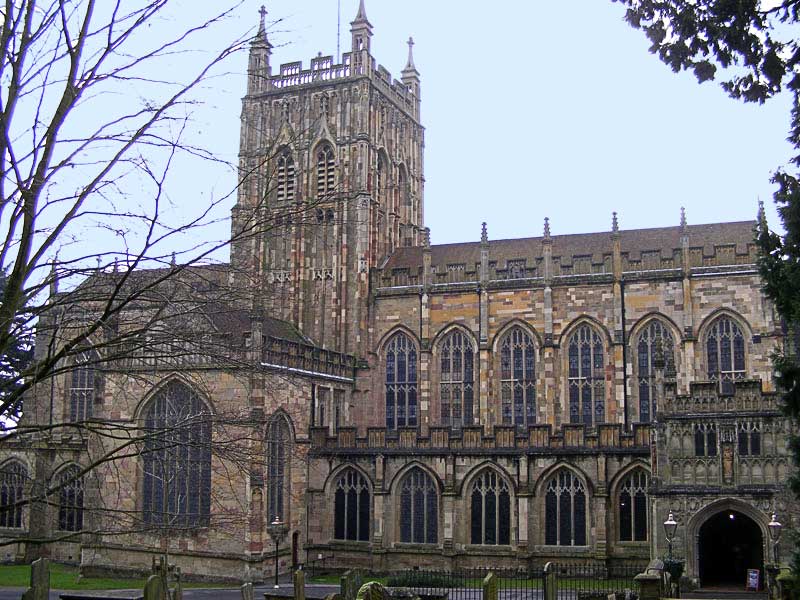
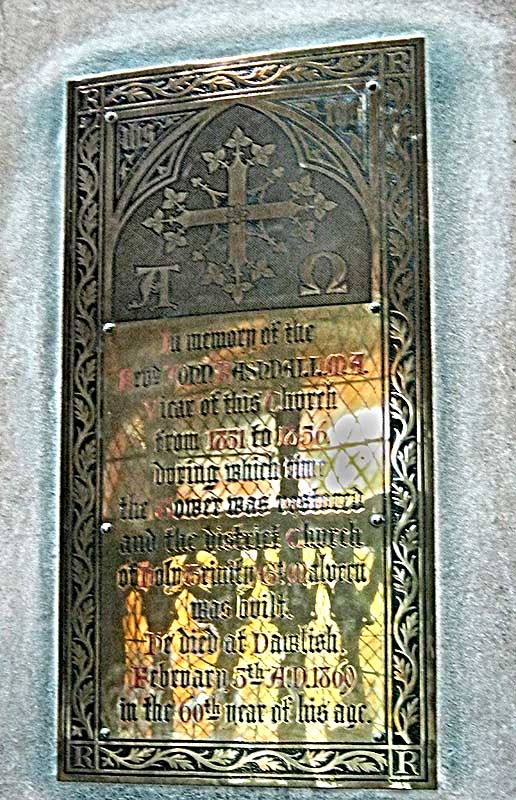 Behind
the Apse is a plaque in memory of John Rashdall who was
vicar from about 1850 to 1856. The plaque is mentioned in the book 'The Water Doctor's
Daughters' (ref 1) in which it is said Rev John Rashdall came to Malvern partly to help look
after the children of his sister
Behind
the Apse is a plaque in memory of John Rashdall who was
vicar from about 1850 to 1856. The plaque is mentioned in the book 'The Water Doctor's
Daughters' (ref 1) in which it is said Rev John Rashdall came to Malvern partly to help look
after the children of his sister 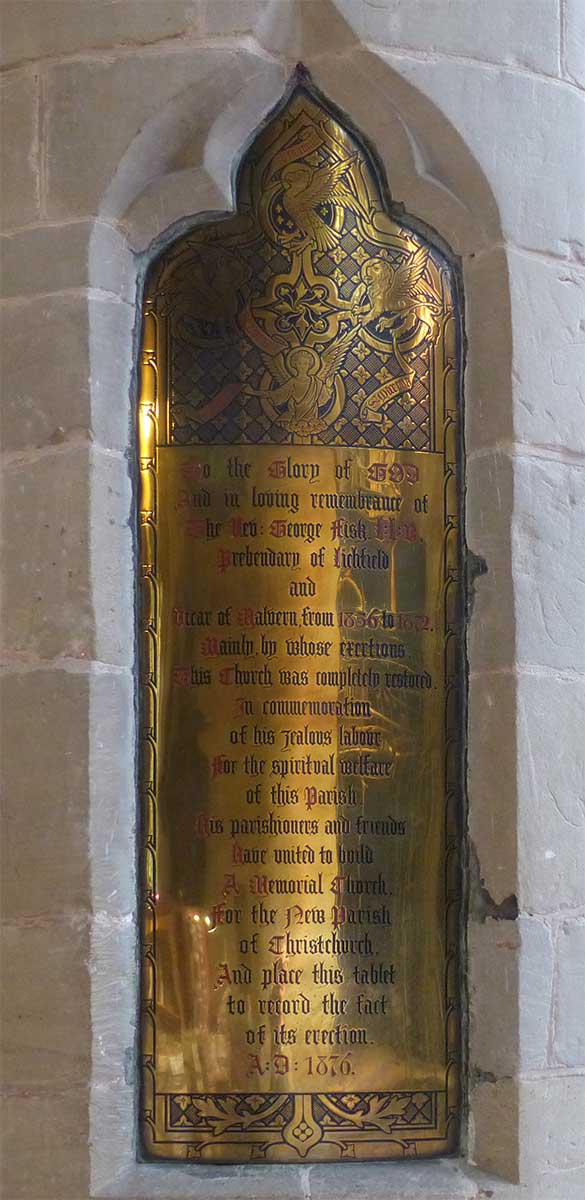 The
inscription on the plaque reads:
The
inscription on the plaque reads: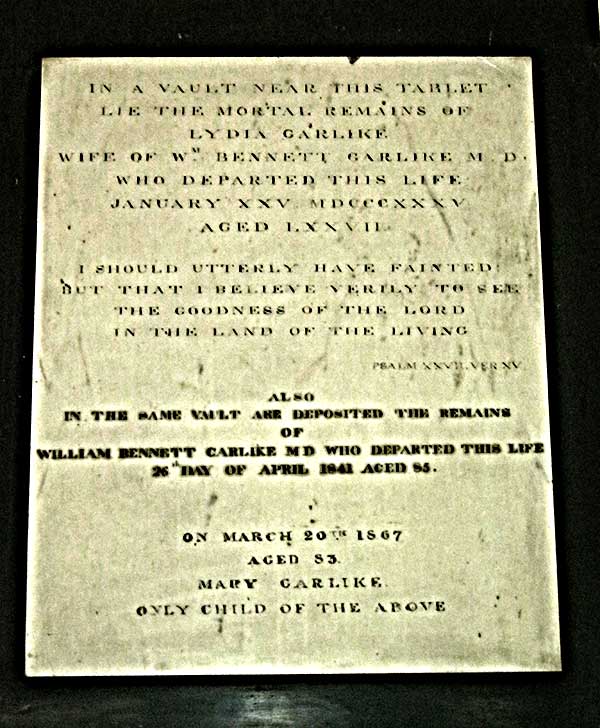 William
Bennett Garlike was a physician who moved to Malvern from Marlborough about
1823. He lived at Melton House on the Wells/Worcester Road which is recorded on
the Foley Estate Map of 1828. He is said to have taken flowers to the
Duchess of Kent and Princess Victoria when they visited Malvern in 1830 (ref
2).
William
Bennett Garlike was a physician who moved to Malvern from Marlborough about
1823. He lived at Melton House on the Wells/Worcester Road which is recorded on
the Foley Estate Map of 1828. He is said to have taken flowers to the
Duchess of Kent and Princess Victoria when they visited Malvern in 1830 (ref
2).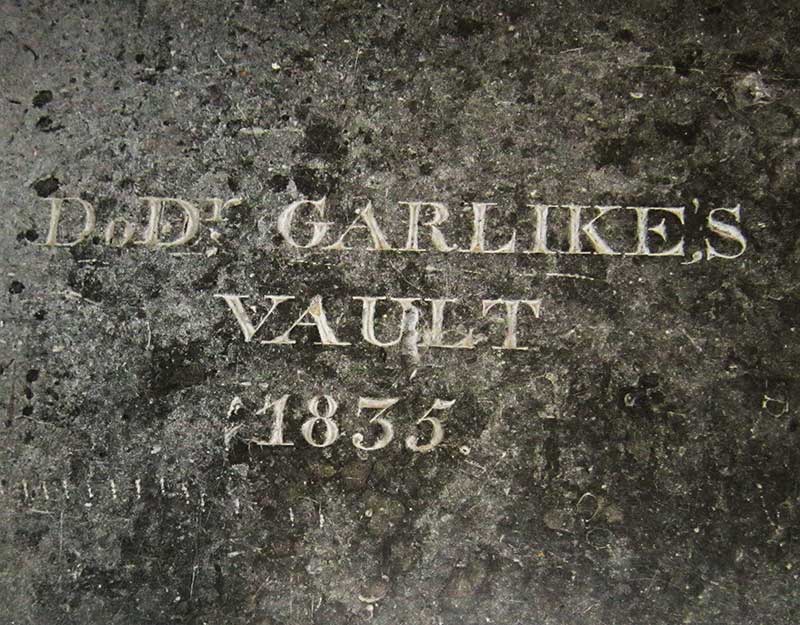 There is also a black ledgerstone at the east end of the south aisle of
the Priory. It reads,
There is also a black ledgerstone at the east end of the south aisle of
the Priory. It reads,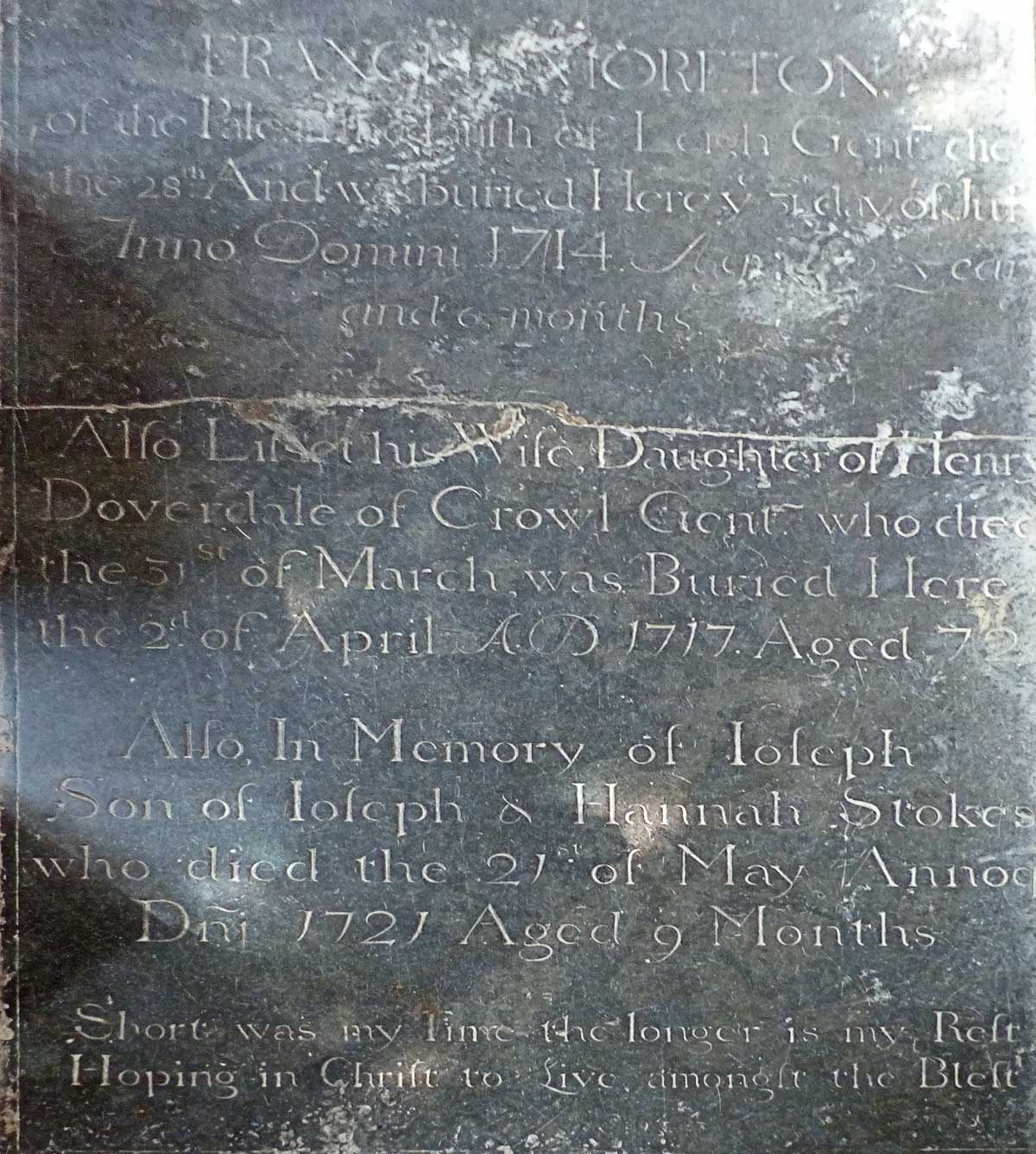 There
are a number of other, older, ledgerstones set in the floor of the south aisle. One
of these for example records:
There
are a number of other, older, ledgerstones set in the floor of the south aisle. One
of these for example records: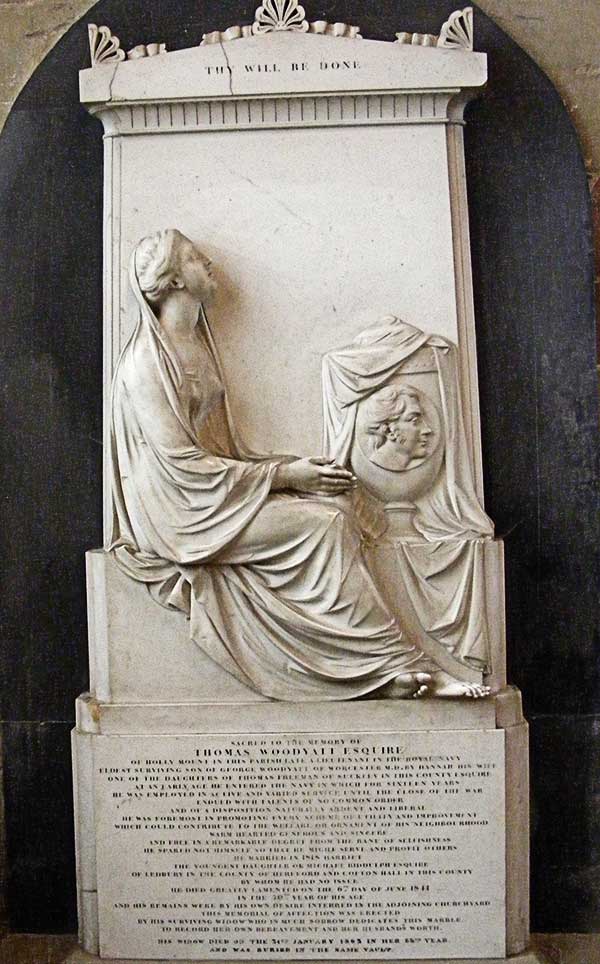 Sacred
to the memory of Thomas Woodyatt Esquire of Holly Mount in this parish late
a lieutenant in the Royal Navy, eldest surviving son of
Sacred
to the memory of Thomas Woodyatt Esquire of Holly Mount in this parish late
a lieutenant in the Royal Navy, eldest surviving son of
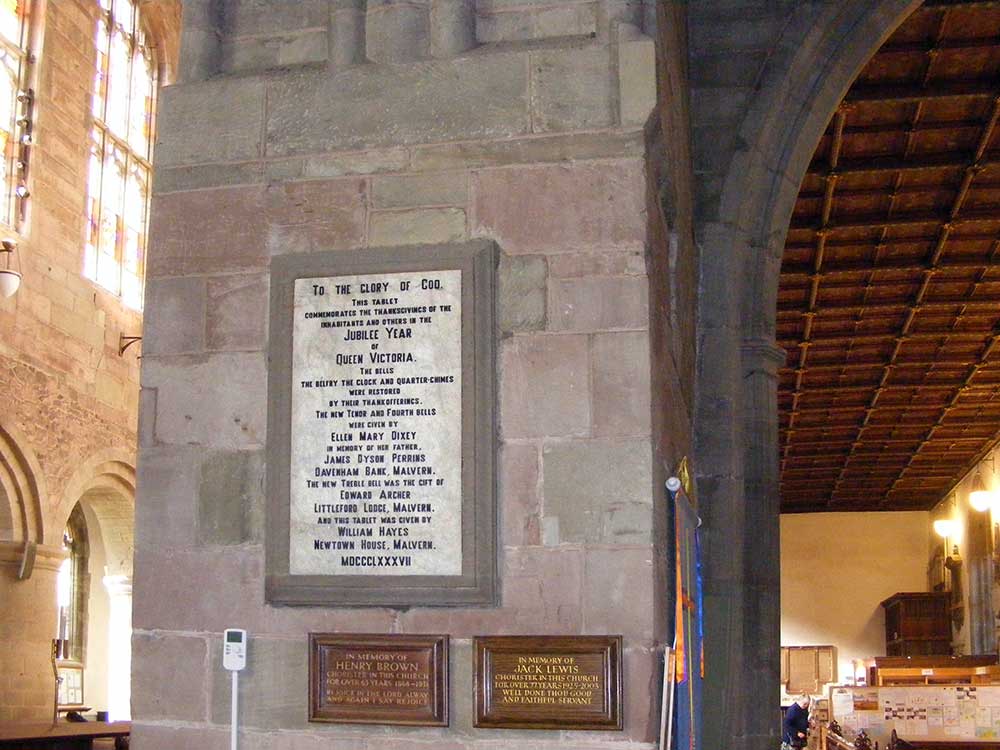
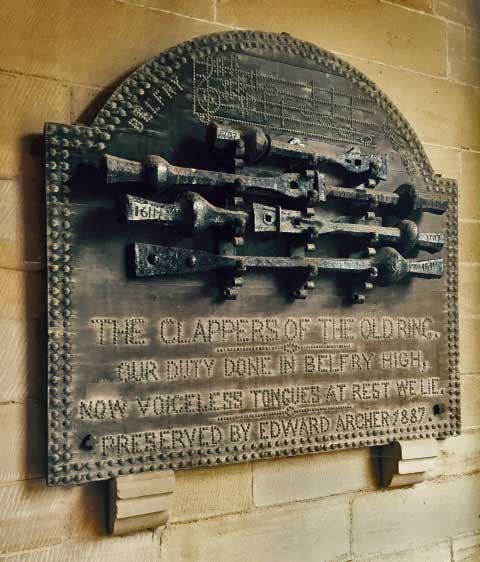 Inside
the church porch are the clappers of the old bells.
Inside
the church porch are the clappers of the old bells.